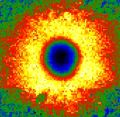Speaker
Description
Membrane models are a versatile tool for understanding the fundamental mechanisms of cellular function. Their applications range from the modelling of complex biological processes and protein characterization to the development of biosensors and drug delivery systems.
This work deals with cellular membrane model preparation on microfluidic devices.
It focuses on free-standing planar lipid bilayers which are easily accessible by a number of different characterization methods and at the same time exhibit good stability and variability.
This work summarizes means of microfluidic device fabrication, phospholipid bilayer formation mechanisms, and characterization methods of those systems.
It showcases the design and preparation of a microfluidic chip on which a stable planar lipid bilayer can be prepared. It therefore presents a microfluidic device prepared by lithography techniques adapted for model membrane formation by self-assembly of phospholipids at the interface of aqueous and organic phases created by the architecture of the microfluidic device. The formation of the model membrane was visualized by optical microscopy and fluorescence lifetime imaging microscopy.

